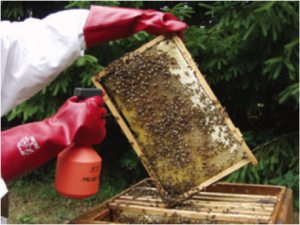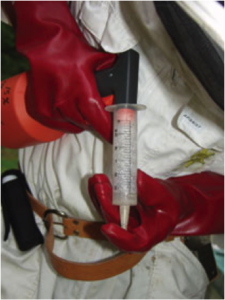Skrevet af: Camilla J. Brødsgaard, Danmarks Jordbrugs-Forskning, Projektgruppe Biavl & Carsten W. Hansen, Danmarks Biavlerforening
TREATING ADULT BEES USING LACTIC ACID

Lactic acid is an organic acid which is distributed widespread in nature. It is formed, for example, in the human body when energy is burnt as well as occurring naturally in honey and other foodstuffs. Furthermore, lactic acid is often added to our foodstuffs.
SAFETY MEASURES
A 15% lactic acid solution is used for treating varroa. This concentration causes irritation to skin and mucous membranes and should be handled with care. Rubber gloves, protective glasses and masks are recommended . In a concentrated form lactic acid is corrosive, and should one get concentrated acid on one’s skin water should be applied liberally. Likewise , if eyes come into contact with the acid,they should be rinsed with water for at least 15 minutes, and medical help should then be sought. If one mixes the solution oneself, one should remember to add the acid to the water and not the other way round, to avoid the possibility of the acid boiling over. The mixture is then stirred until the lactic acid is evenly distributed. This mixture will last for a few months, but must not be stored at under 0°C.
TRACES IN WAX AND HONEY
Following treatment the lactic acid content of honey increases for only a short while, as the product breaks down fairly quickly. After circa eight weeks the lactic acid content is down to normal levels.
RESISTANCE
No problems concerning the varroa mite building up a resistance to lactic acid have been noted.

WHEN CAN IT BE USED?
Lactic acid can be used up to eight weeks before the honey harvest. Lactic acid treatment should only be carried out in colonies without brood, since lactic acid does not penetrate the sealed brood.
It is most suitable to use lactic acid in the autumn, when there are not sizable amounts of brood in the colonies. Quite often there are a number of mild days in October, in which treatment can ideally be carried out. It will also be possible to carry out a treatment very early in Spring, if one has a feeling that there are too many mites in the colony. However, before they have large amounts of sealed brood ,it is difficult to work with bees, and the treatment would achieve too small an effect. Take note that in some cases queen loss has been recorded in connection with spring treatment.
Lactic acid is very useful in treating swarms. Bees to be used in mating cassettes can also be treated with lactic acid.
HOW IS IT USED?
Three treatments should be carried out with two day intervals. A 15% solution should be used, and 5 ml should be applied with a water sprayer to each side of each frame. The necessary number of pumps required on the spray should be tested beforehand. Treatment should be carried out either so early or late in the day that there is no noticeable flying activity. The lactic acid is sprayed on the bees so that they all become damp. If there are sealed brood present in the colony during this first treatment, they should be removed. A moderate removal of brood can be carried out in Autumn without weakening the colony, but it is not advisable to do so in Spring, since the first bees to develop are of vital importance to the later development of the colony. With a little practice, three treatments with a water-sprayer can be carried out in about 10 minutes per colony.
THE EFFECT
When lactic acid is used in a colony without brood, the effectiveness of the treatment is very high. In tests carries out jointly by The Danish Beekeepers Association and The Danish Agricultural Research Station’s “ Project Beekeeping”, a mortality of 95% or more has been recorded.
THE COST OF TREATMENT
A 30 Kg. container of 80% lactic acid purchased at The Danish Dairy Wholesalers costs ca. £60 + VAT. It can also be purchased at beekeepers suppliers and at pharmacies in small bottles, but at a far higher price.
In the treatment of a colony on ten frames about 0.3 L of 15% lactic acid solution is used. Through bulk buying the price for this amount is about 10p.